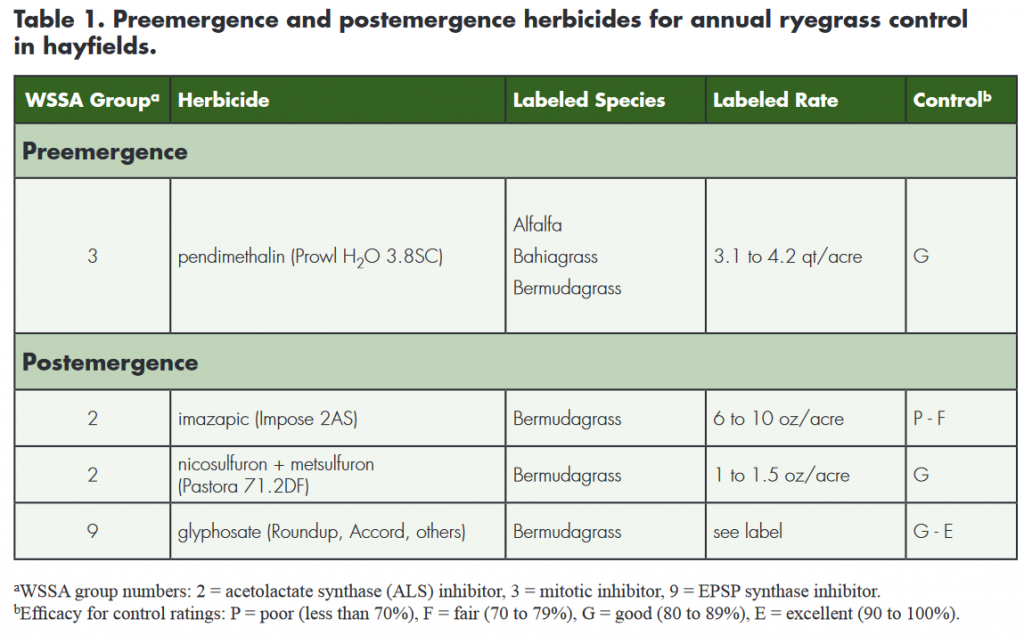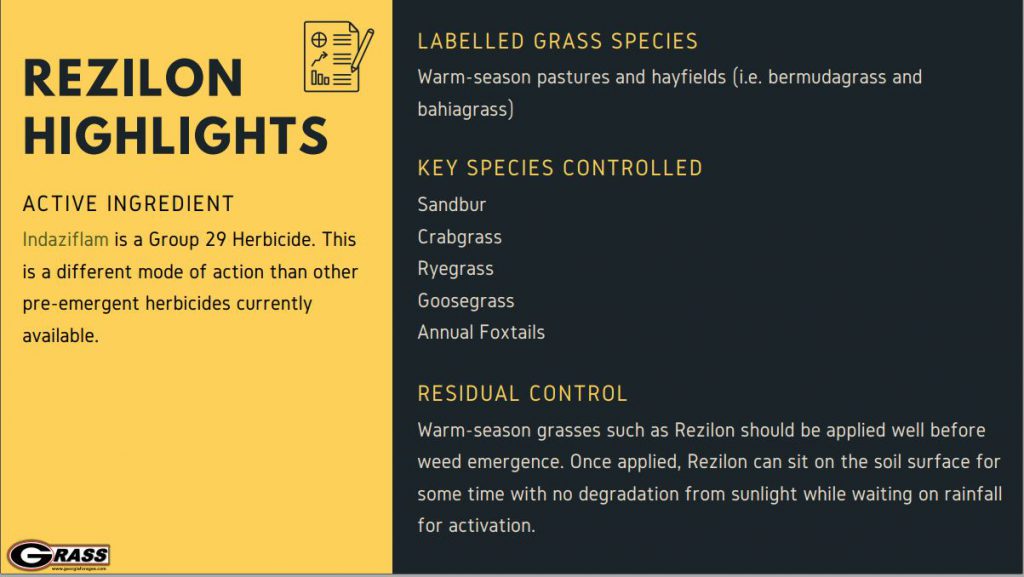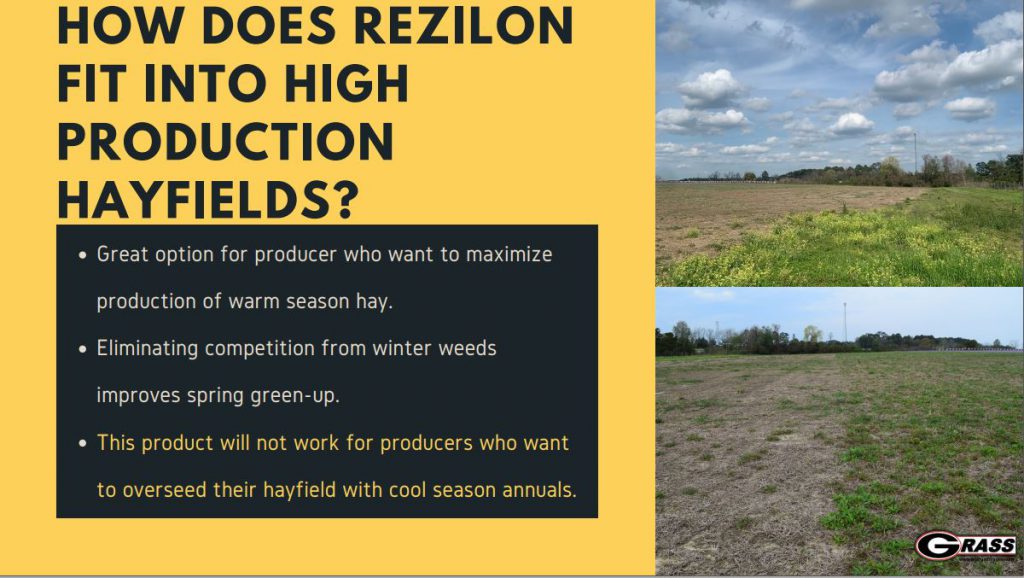Hay producers often ask questions about ryegrass control in hayfields this time of year. Annual ryegrass (Lolium multiflorum), also referred to as Italian ryegrass, is the most problematic winter annual weed in Georgia hayfields. Ryegrass seed can germinate from September to November when soil temperatures drop below 70 degrees F. Annual ryegrass grows well under cool conditions when pasture grasses are dormant or if there is limited competitive growth. Annual ryegrass can affect the spring green-up of perennial forage grasses.
Bermudagrass hay fields can be impacted by ryegrass in several ways. Nutrients such as nitrogen and potassium can be used by ryegrass which can result in a reduction in yield. Weed encroachment, increased disease pressure, drought stress and overall stand decline can be influenced by ryegrass competition in hayfields. Research results from a North Carolina indicate that ryegrass can reduce forage yield be as much as 50 percent.
Ryegrass is a prolific seed producer and can produce seed heads in March. Seed can remain dormant in the soil for a long period of time. If you need to do aeration, sub soiling or other tillage operations in your bermudagrass or bahiagrass stands please do it during periods of active growth. The tillage operations can germinate seeds. Mowing before seedhead formation can help suppress seed production.
Ryegrass control options include pre emerge applications of Prowl H20 and post emerge options of Impose, Pastora and glyphosate. Table 1 below shows preemergence and postemergence herbicides for annual ryegrass control in hayfields..

According to the UGA publication Annual Ryegrass Control in Georgia Hayfields. Dr. Patrick McCullough, UGA Weed Control Specialist, is the lead author of this publication.
The best timing for postemergence control of annual ryegrass is when plants are less than 6 inches in height in the fall. Bermudagrass growers may use Impose 2AS (imazapic) or Pastora 71.2DF (nicosulfuron + metsulfuron) for annual ryegrass control, but these products are not labeled for bahiagrass and tall fescue due to excessive injury potential (Table 1). Postemergence herbicides are more effective in early winter, compared to spring timings, because of the size and maturity of plants at application. Annual ryegrass is generally susceptible to postemergence herbicides in early winter prior to the onset of freezing temperatures and before seedhead emergence. Pastora is more effective than Impose at labeled use rates in bermudagrass hayfields. Pastora 71.2DF at 1 to 1.25 ounces per acre is recommended in November or early December in bermudagrass. Impose 2AS (imazapic) controls annual ryegrass in the fall, but requires high rates (8 to 10 ounces per acre) on plants greater than 6 inches in height. Bermudagrass is also more susceptible to injury from Impose than Pastora, especially at rates required for annual ryegrass control. Both herbicides require a non-ionic surfactant at 0.25 percent volume of solute/volume of solution (1 quart per 100 gallons). If growers must apply herbicides in January or February, it is recommended that Pastora treatments have a tank-mixture with glyphosate to enhance control. Moderate rates of glyphosate in bermudagrass, such as 0.125 to 0.25 pound acid equivalent (a.e.) per acre, generally do not affect spring transition when applied in winter. However, glyphosate use in the spring could cause delayed green-up and growth inhibition to bermudagrass. Poast (sethoxydim) controls ryegrass in legumes, but it is not labeled for grassy hayfields. Growers have no selective herbicides available for postemergence control of annual ryegrass in bahiagrass or tall fescue grown for hay. Spot treatments of glyphosate are recommended in these species for control. A 0.5 to 1 percent solution of glyphosate should be sprayed to annual ryegrass shoots until runoff occurs. Growers should check the product label of certain glyphosate products, and include an adjuvant at 1 percent v/v if needed.
If you would like more information on perennial forage weed control please go the UGA Pest Management Handbook.
A major limitation to postemergence control of annual ryegrass is herbicide resistance. According to Dr. McCullough, resistance of annual ryegrass to acetolactate synthase inhibitors (for example, Impose or Pastora), acetyl CoA-carboxylase inhibitors (for example, sethoxydim), and glyphosate has been confirmed in Georgia. If you have any questions about this contact your local county agent.
What about Rezilon? According to the 2021 UGA Pest Management Handbook, Rezilon is a preemergence herbicide for controlling annual grass and broadleaf weeds in established bermudagrass and bahiagrass pastures that are grazed or grown for hay. The application rate 3 to 5 oz per acre. There are no restrictions for animals grazing a site treated with Rezilon. Do not exceed 5 fl oz per acre in a single application. Do not exceed 6 fl oz per acre in a 12-month period. Do not harvest hay within 40 days of any single application of rates that exceeds 3 fl oz/acre. Do not make more than two applications in a 12-month period. Allow 60 days between applications. Do not overseed cool season grasses for winter grazing for a period of at least 18 months after the last application of Rezilon.
Dr. Lisa Baxter, UGA Forage Specialist, provided county agents information about Rezilon. Topics include species that it will control, how does it fit into grazing and hay production systems, and also how will it help with weed resistance.




If you would like to view a webinar on this new herbicide for forage production systems then go to this link..
If you would need more information please contact your local county agent.
